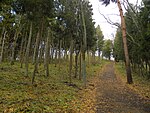

| UNESCO World Heritage Site | |
|---|---|

Pure Land Garden of Mōtsū-ji
| |
| Location | Hiraizumi, Nishiiwai District, Iwate Prefecture, Japan |
| Criteria | Cultural: (ii), (vi) |
| Reference | 1277rev |
| Inscription | 2011 (35th Session) |
| Area | 176.2 ha (435 acres) |
| Buffer zone | 6,008 ha (14,850 acres) |
| Coordinates | 39°0′4″N 141°6′28″E / 39.00111°N 141.10778°E / 39.00111; 141.10778 |
|
Location of Historic Monuments and Sites of Hiraizumi in Japan | |
Hiraizumi – Temples, Gardens and Archaeological Sites Representing the Buddhist Pure Land is a grouping of five sites from late eleventh- and twelfth-century Hiraizumi, Iwate Prefecture, Japan. The serial nomination was inscribed on the UNESCO World Heritage List in 2011, under criteria ii and vi.[1][2]
For four generations from c.1087, when Fujiwara no Kiyohira moved his headquarters and residence from further north, until 1189, when the army of Minamoto no Yoritomo put an end to the Northern Fujiwara, Hiraizumi served as an important political, military, commercial, and cultural centre.[3][4] Several major temples associated with Pure Land Buddhism were founded and endowed, but the demise of their benefactors and a series of fires contributed to their subsequent decline. When Bashō visited in 1689 he was moved to write, in Oku no Hosomichi: summer grass... remains of soldiers' dreams.[5][6] A series of excavations from the mid-twentieth century onwards combined with references in Azuma Kagami, in particular the Bunji-no-chūmon petition of 1189, and the Shōwa sojō or "monks' appeal" of 1313 from the Chūson-ji archives, has contributed much to the understanding of the sites and the period.[7][8]
| Name | Type | Comments | Image | Coords |
|---|---|---|---|---|
| Chūson-ji 中尊寺境内 Chūsonji keidai |
Temple | Said to have been founded by Ennin in 850; rebuilt by Fujiwara no Kiyohira at the beginning of the twelfth century with a pagoda and the Daichōju-in, a Great Hall dedicated to Amida; fires in 1337 consumed many buildings and temple treasures; unusually, the mummified bodies of Fujiwara no Kiyohira and his heirs were interred at the Konjikidō, the Hall of Gold dedicated to Amida (pictured; National Treasure); the compound is a Special Historic Site[9][10][11] |  |
39°00′07″N 141°06′00″E / 39.00186419°N 141.10007091°E / 39.00186419; 141.10007091 (Chūson-ji) |
| Mōtsū-ji 毛越寺境内 Mōtsūji keidai |
Temple | Said to have been founded by Ennin in 850; rebuilt by Fujiwara no Motohira in the twelfth century; its destruction by fire in 1226 was lamented in Azuma Kagami as the loss of a monument 'incomparable in our time'; the twelfth-century paradise garden, with stone-paved stream, pond, pebble beach, peninsula, island, and ornamental stones is a Special Place of Scenic Beauty; the precinct and associated tutelary shrine is a Special Historic Site[12][13][14][15] |  |
38°59′26″N 141°06′56″E / 38.99053116°N 141.11545706°E / 38.99053116; 141.11545706 (Mōtsū-ji) |
| Kanjizaiō-in Ato 観自在王院跡 Kanjizaiōin ato |
Temple | Founded adjacent to Mōtsū-ji with two Amida Halls by the wife of Fujiwara no Motohira in the twelfth century; destroyed by fire in 1573; its twelfth-century paradise garden with stream, pond, pebble beach, island, and waterfall stone arrangement is a Place of Scenic Beauty[14][16][17][18] |  |
38°59′17″N 141°06′37″E / 38.9881789°N 141.11037523°E / 38.9881789; 141.11037523 (Kanjizaiō-in Ato) |
| Muryōkō-in Ato 無量光院跡 Muryōkōin ato |
Temple | Founded with a monumental statueofAmidabyFujiwara no Hidehira in the twelfth-century; modelled on Byōdō-in near Kyoto; twelfth-century paradise garden with pond, island and ornamental stones; a Special Historic Site[14][19][20][21] |  |
38°59′35″N 141°06′57″E / 38.99293001°N 141.1158882°E / 38.99293001; 141.1158882 (Muryōkō-in Ato) |
| Mount Kinkeisan 金鶏山 Kinkeizan |
Mountain | Summit used for sutra burials; remains of a Hall identified as belonging to Zaō Gongen; associated with the cult of Miroku; a historic site[22][23][24] |  |
38°59′36″N 141°06′33″E / 38.99335037°N 141.10920153°E / 38.99335037; 141.10920153 (Mount Kinkeisan) |
The original 2006 nomination of "Hiraizumi - Cultural Landscape Associated with Pure Land Buddhist Cosmology" included five further sites while omitting that of Kanjizaiō-in as a separate component.[25] Four were removed from the nomination after the failure to secure inscription in 2008; the component site of the Yanagi Palace was excluded from the 2011 inscription, although there are continuing efforts to secure its inclusion through future extension.[26][27]
Yiengpruksawan, Mimi Hall (1998). Hiraizumi: Buddhist Art and Regional Politics in Twelfth-Century Japan. Harvard University Press. ISBN 0-674-39205-1.
| International |
|
|---|---|
| National |
|